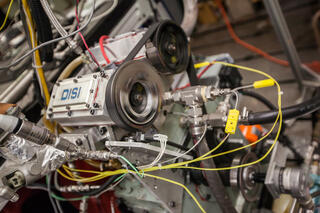Trees could hold the solution to cleaner burning engines

Researchers discovered that methylbutenol, a compound produced by some pine trees, outperformed two more common biofuels, ethanol and isobutanol in lab tests.
The Science
Particulate matter, also known as soot, in vehicle exhaust is a major environmental and health concern. Engine knock, which happens when fuel ignites at the wrong time, reduces fuel efficiency and can damage engine parts. Two recent studies showed that methylbutenol, a type of alcohol produced by some North American pine trees, creates less soot and resists engine knock better than two other biofuels when burned in an internal combustion engine. Blended with gasoline, methylbutenol beat out ethanol and isobutanol in laboratory tests.
The Impact
Adding renewable fuels like alcohols to gasoline can reduce engine knocking, improve air quality, and lower greenhouse gas emissions from motor vehicles. Ethanol is the most common fuel additive in the United States, but it contains less energy than gasoline and changes the overall fuel properties, which can lead to increased air pollution. Isobutanol and methylbutenol are more similar to gasoline, and both can be produced from non-food plants using modified bacteria, making them attractive low-carbon replacements for fossil fuels. While ethanol and isobutanol are approved biofuels under the Clean Air Act, there has been little study of MBO as a fuel additive. These studies show MBO is a potentially promising biofuel worthy of additional research.
Summary
Scientists with the Great Lakes Bioenergy Research Center used a special single-cylinder engine in a laboratory to test each alcohol blended with gasoline. Ethanol was blended at 10, 20, and 30% by volume. Isobutanol (2-methyl-1-propanol) and methylbutenol (2-methyl-3-buten-2-ol) blends were matched to ethanol on an oxygen weight percentage basis, resulting in isobutanol blends of 16, 32, and 49% and methylbutenol blends of 18, 37, and 56%.
Higher alcohol concentrations consistently reduced sooting and particulate emissions in each blend. At higher concentrations, isobutanol produced less soot than ethanol while methylbutenol produced less soot than either of the other alcohols.
At low concentrations, ethanol and methylbutenol did slightly better than isobutanol at reducing engine knock. At higher levels, ethanol and isobutanol performed similarly, but methylbutenol did significantly better.
Contact
Stephen Sakai
University of Wisconsin–Madison
ssakai@wisc.edu
David Rothamer
University of Wisconsin–Madison
rothamer@engr.wisc.edu
Related Links
- Trees may hold the solution for keeping engines running smoothly and efficiently, Wisconsin Energy Institute
- UW–Madison team finds methylbutenol a potentially promising biofuel for blending with gasoline, Green Car Congress